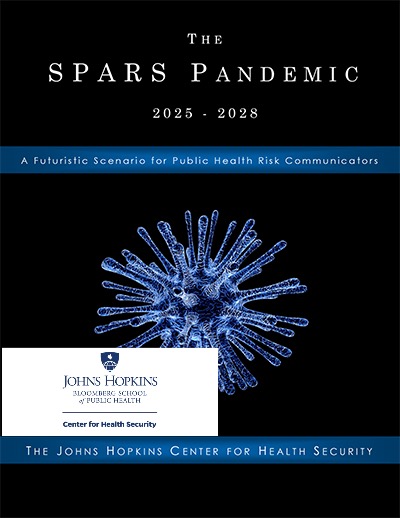In 2017 Johns Hopkins Center for Health Security released a scenario analysis called The SPARS Pandemic (2025-2028). This was a futuristic fictional scenario about a potential coronavirus that sweeps across the world sometime in the future (2025-2028). This document has been publicly available in the past three and half years. Many of the events and the timeline included in this document are eerily similar to the COVID-19 pandemic.
(Pages 1-2) POSSIBLE FUTURE IN 2025: THE “ECHO CHAMBER”: In the year 2025, the world has become simultaneously more connected, yet more divided. Nearly universal access to wireless internet and new technology—including internet accessing technology (IAT): thin, flexible screens that can be temporarily attached to briefcases, backpacks, or clothing and used to stream content from the internet—has provided the means for readily sharing news and information.
However, many have chosen to self-restrict the sources they turn to for information, often electing to interact only with those with whom they agree. This trend has increasingly isolated cliques from one another, making communication across and between these groups more and more difficult...Ultimately, a world comprised of isolated and highly fragmented communities with widespread access to information technology—dubbed “the echo-chamber”—was selected as the future in which the prospective scenario would take place.
(Page 6) - "The virus [SPARS] had an extended incubation period (seven to ten days) compared to its latent period (four to five days). Thus, infected persons could spread the virus for up to nearly a week before showing symptoms of the disease themselves. As a result, isolating sick SPARS patients proved to be less effective than isolating patients infected by other, better-characterized respiratory diseases.
(Page 8) - Early in the SPARS pandemic, public health and medical professionals were hopeful that the outbreak could be contained through case identification and isolation. It quickly became clear, however, that this strategy was not as effective as initially hoped. First, challenges in identifying mild cases limited the impact of isolation programs. Because the initial symptoms of SPARS closely resembled influenza, many who contracted SPARS did not immediately seek care, assuming they merely had the flu.
(Page 49) - In September 2026, two months after the first batches of Corovax were released in the United States, Japan announced that it would not approve the vaccine for use in Japan due to concerns that it had not been vetted properly through full clinical trials. Preliminary Corovax trials conducted in Japan had shown that the vaccine was effective at preventing SPARS and that the incidence of immediate side effects was minimal; however, significant concerns remained about the possibility of chronic, long-term side effects based on data from the original GMI vaccine.
(Pages 55, 56) - By January 2027, efforts to vaccinate the entire US population were actively underway. Global vaccination efforts up to this point were limited by vaccine supply, and while they had a moderate effect on SPARS incidence rates, the disease continued to spread steadily worldwide..... A new challenge soon emerged, however: antibiotic shortages. In late 2026, at the height of the cold and flu season, bacterial pneumonia cases were on the rise across the country. Epidemiologic evidence later indicated that thirty to forty percent of children and ten to twenty percent of adults developed secondary bacterial pneumonia approximately four to eight months after initial SPARS infections.
(Pages 59) - As time passed and more people across the United States were vaccinated, claims of adverse side effects began to emerge. Several parents claimed that their children were experiencing neurological symptoms similar to those seen among livestock exposed to the GMI vaccine. By May 2027, parental anxiety around this claim had intensified to the point of lawsuits. That month, a group of parents whose children developed mental retardation as a result of encephalitis in the wake of Corovax vaccination sued the federal government, demanding removal of the liability shield protecting the pharmaceutical companies responsible for developing and manufacturing Corovax.
The growing plaintiff cohort quickly withdrew their suit upon learning that the National Vaccine Injury Compensation Trust Fund (NVICTF) and an emergency appropriation of funds authorized by Congress under the PREP Act existed to provide financial reimbursement to those who were adversely affected by the Corovax vaccine in order to cover healthcare costs and other related expenses.



